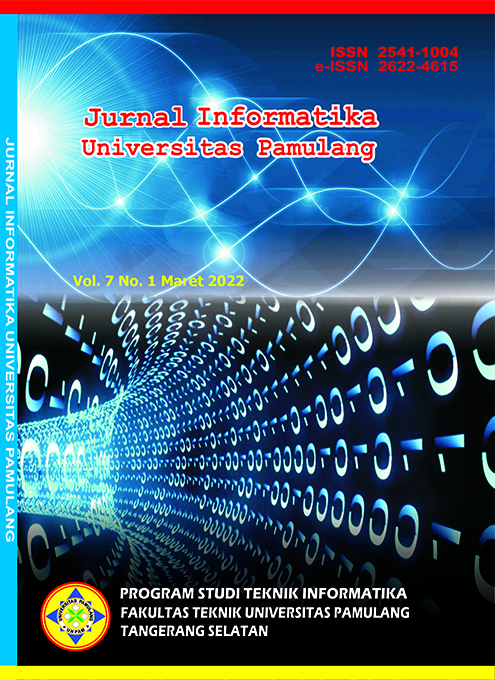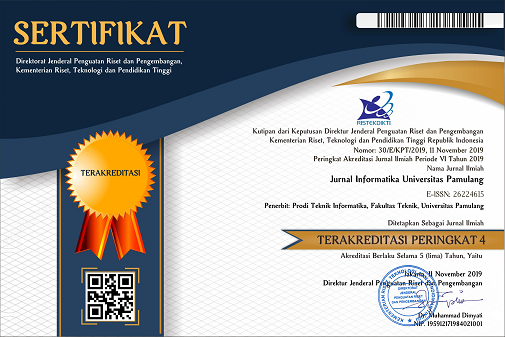Pengembangan Sistem Aplikasi Penerimaan Siswa Baru di Madrasah Ibtida’iyah AL-Falahiyah Berbasis Desktop dengan Menggunakan IDE Netbeans
DOI:
https://doi.org/10.32493/informatika.v7i1.20610Keywords:
Netbeans, Waterfall, Application Development, PlanningAbstract
This development information technology makes it easy for us to get, process and present information. The information referred to is for example the collection and processing of data to provide information. One application of information technology is the development of new student admission applications in schools. With the development of this application, it can make it easier for school admins to document the data needed or used in schools. This information data can be taken from filling out forms and or voice recordings which will later be input into the computer application system that will be developed at this time. The application development method used is the Waterfall Method, which has an understanding of the earliest software development method and this method has a natural nature. This meetode has several sequences that must be completed in its entirety, the sequence is the Planning/Planning Process, Analysis, Design, Implementation and Application Testing. If it is described in more detail, the steps that must be passed are a systematic approach to get a good plan, leading to the analysis, design, conditioning, testing/verification and maintenance/maintenance stages. The steps contained in the waterfall method must be passed and completed one by one (cannot jump to the next stage if the stages have not been completed) and run sequentially. This serves to ensure that the quality of the applications obtained can produce and provide good system applications. Application development for new student admissions at this school can have a good impact on the school administration system, such as making it easier for school admins to search for detailed teacher and student biodata. at the school, the grouping of new students into several classes, setting the schedule for school subjects per grade level, to providing grade values from the results of the per-student learning scores of each subject in the school.
References
Andita, A. P., & Astuti, P. (2020). Penerapan metode waterfall dalam pembuatan sistem informasi dana kas kecil pada pt. natur pesona indonesia. Jurnal Sains Dan Manajemen, 8(1), 36-45.
Andriansyah, D. (2018). Penerapan Model Waterfall Pada Sistem Informasi Layanan Jasa Laundry Berbasis Web. Indonesian Journal on Software Engineering (IJSE), 4(1), 27-32.
Habibby, A. I., & Yamasari, Y. (2017). Sistem Informasi Sekolah Berbasis WEB (Studi Kasus : TK Kusuma Putra Kota Mojokerto). Jurnal Manajemen Informatika, 7(2), 94-100.
Mulyono, T. (2018). Penerapan Metode Waterfall Dalam Perancangan Website Rental Mobil DI CV. Ardiva Gresik. Jurnal Teknologi dan Terapan Bisnis, 1(2), 117-121.
Nurseva, S., & Lutfiyana, N. (2019). Metode Waterfall pada Perancangan Website Pelayanan Jasa Penyewaan Sepeda. Journal of Information System, 3(2), 131-140.
Rifai, A., & Yuniar, Y. P. (2019). Penerapan Metode Waterfall Dalam Perancangan Sistem Informasi Ujian Pada SMK Indonesia Global Berbasis Web. Jurnal Khatulistiwa Informatika, 7(1).
Rosmalasari, T. D., Lestari, M. A., & Dewantoro, F. (2020). Pengembangan E-Marketing Sebagai Sistem Informasi Layanan Pelanggan Pada Mega Florist Bandar Lampung. Journal of Social Sciences and Technology for Community Service (JSSTCS), 1(1), 27-32.
Septiani, M., & Nurvitaliah, F. (2018). Sistem penggajian karyawan pt. neo bogor dengan menggunakan metode waterfall. Journal of Informatics, 3(1), 11-20.
Suryadi, A., & Zulaikhah, Y. S. (2019). Rancang Bangun Sistem Pengelolaan Arsip Surat Berbasis Web Menggunakan Metode Waterfall. Jurnal Khatulistiwa Informatika, 7(1).
Udi, U. (2018). Penerapan Metode SDLC Waterfall Dalam Pembuatan Sistem Informasi Akademik Berbasis Web Studi Kasus Pondok Pesantren Al-Habib Sholeh Kabupaten Kubu Raya, Kalimantan Barat. Jurnal Teknologi Dan Manajemen Informatika, 4(1).
Yulia, E. R., Ernawati, S., & Wati, R. (2018). E-Commerce Sparepart Motor Menggunakan Metode Waterfall (Studi Kasus: Bengkel Proklamasi Jaya Motor). Jurnal Teknik Komputer, 4(2), 7-12.
Downloads
Published
Issue
Section
License
Authors who publish with this journal agree to the following terms:
- Authors retain copyright and grant the journal right of first publication with the work simultaneously licensed under a Creative Commons Attribution-NonCommercial 4.0 International (CC BY-NC 4.0) that allows others to share the work with an acknowledgement of the work's authorship and initial publication in this journal.
- Authors are able to enter into separate, additional contractual arrangements for the non-exclusive distribution of the journal's published version of the work (e.g., post it to an institutional repository or publish it in a book), with an acknowledgement of its initial publication in this journal.
- Authors are permitted and encouraged to post their work online (e.g., in institutional repositories or on their website) prior to and during the submission process, as it can lead to productive exchanges, as well as earlier and greater citation of published work (See The Effect of Open Access).
Jurnal Informatika Universitas Pamulang have CC-BY-NC or an equivalent license as the optimal license for the publication, distribution, use, and reuse of scholarly work.
In developing strategy and setting priorities, Jurnal Informatika Universitas Pamulang recognize that free access is better than priced access, libre access is better than free access, and libre under CC-BY-NC or the equivalent is better than libre under more restrictive open licenses. We should achieve what we can when we can. We should not delay achieving free in order to achieve libre, and we should not stop with free when we can achieve libre.
Jurnal Informatika Universitas Pamulang is licensed under a Creative Commons Attribution-NonCommercial 4.0 International (CC BY-NC 4.0)
YOU ARE FREE TO:
- Share : copy and redistribute the material in any medium or format
- Adapt : remix, transform, and build upon the material for any purpose, even commercially.
- The licensor cannot revoke these freedoms as long as you follow the license terms





